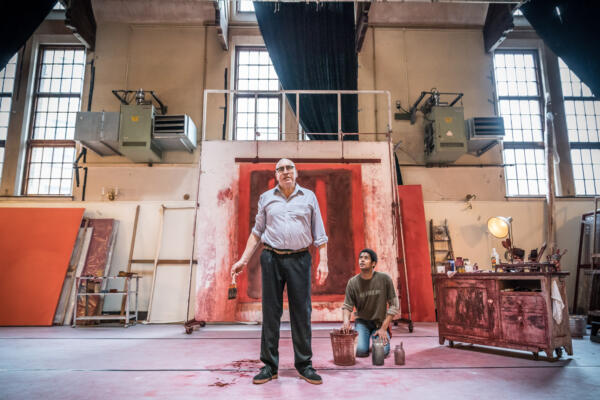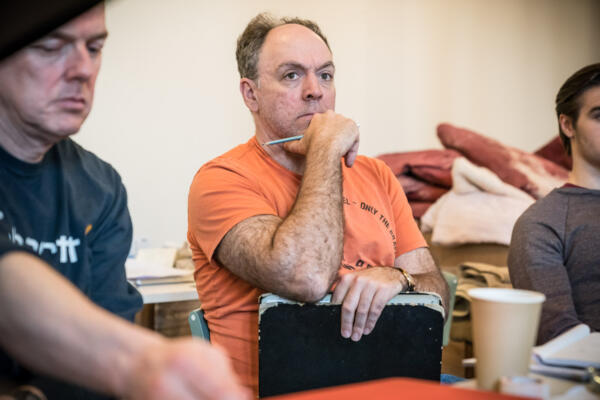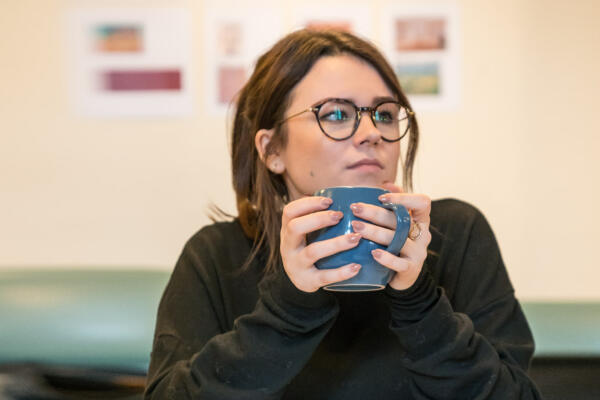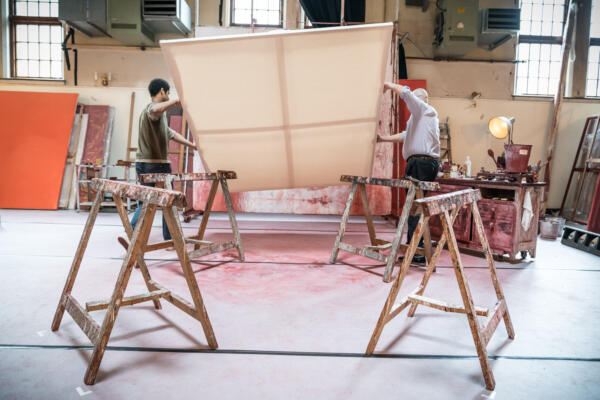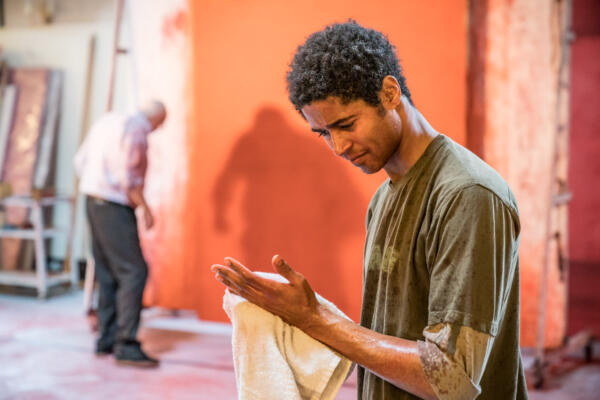Red | Inside the Rehearsal Room
Red– Week Two, Day One
It’s the beginning of the second week of rehearsals and at the start of the day Stage Management are busy setting up the rehearsal room, positioning paintings and lights and checking everything is in place. The canvases themselves are numbered for ease of identification as they represent the Seagram Murals at different stages of completion. Some are simple primed canvases, covered in a base-coat of red paint, while others begin to show the outlines of Rothko’s characteristic rectangular shapes. Company Stage Manager, Greg Shimmin, describes this version of the staging as closer to the New York run eight years ago, where it changed slightly following the first performances at the Donmar Warehouse in 2009 and 2010.
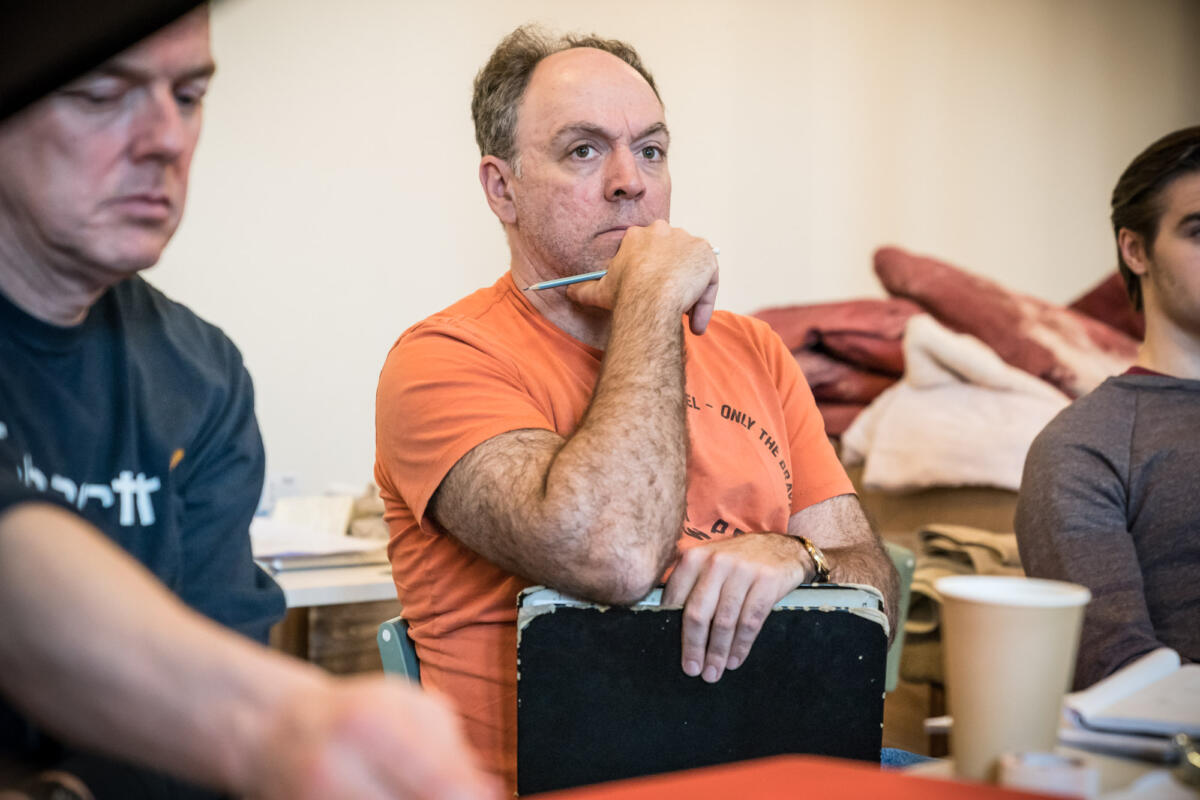
Fred and Alfie run lines and discuss blocking over a cup of tea, both of them trying to be off-book as much as possible from this week on. Meanwhile the Deputy Stage Manager, Nicole Walker, and Assistant Stage Manager, Rhiannon Harper, get the record-player to work, then Rhiannon moves around the set crossing things off a checklist. Also in the room are the understudies, Ian Drysdale and Sam Perry, to observe rehearsals. They have separate sessions with Associate Director, Josh Seymour, on Fridays, who’s been busy putting various visual references on the wall.
Ready to start, Michael welcomes everyone to the room and thanks Stage Management for preparing the space. Fred asks Michael if he wants Alfie and him to start working with all of the props today? Michael says yes. Fred’s also keen to rehearse the scene changes and Michael asks Stage Management for the music to be played in wherever possible – ‘Now that we’ve heard it all.’ They’re starting again from the top of the play. ‘What I’d like to do from today is just start asking more questions,’ says Michael.
Fred gets into position for the opening, sitting in Rothko’s chair. ‘Am I further away than ever before?’ he asks. Stage Management consult their notes and make sure the chair is in the correct position. Michael seeks to clarify the setting of the scene, asking Josh, ‘Can you give us a date?’ It’s August 1958. Fred wonders what time of the morning it is. ‘I like the idea that it’s still early and that you’re drinking,’ says Michael. ‘That’s helpful.’ He reflects a moment then suggests: ‘Let’s say this so we’ve got something down in our books, we can always change it later. Let’s say you’ve arrived at 9am in August 1958 – we should pick a date later – and that you’ve changed and set up the space.’ He prepares the actors to run the scene, commenting on the timing of the opening in terms of Rothko contemplating the paintings and Ken’s arrival – ‘You’re in charge of this moment.’ Referring to the accompanying music, Michael says Stage Management will respond to the actors – ‘Nicole will go off you.’
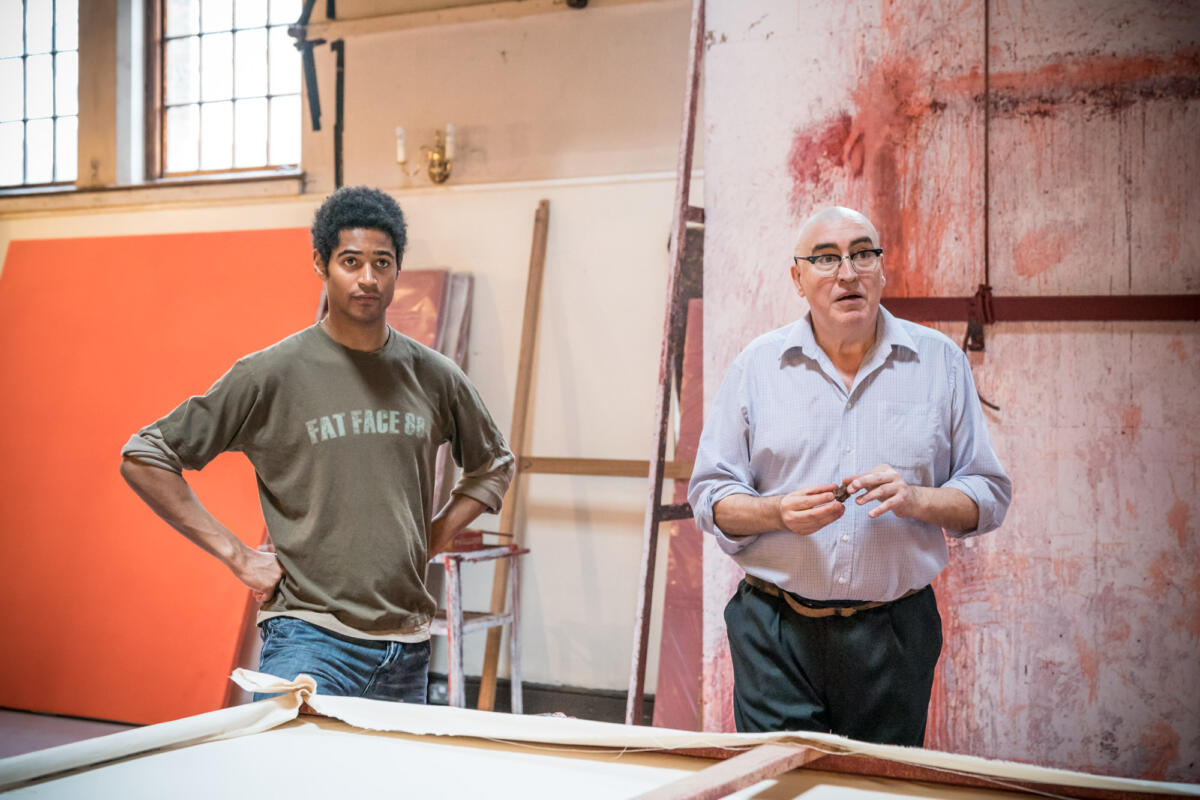
They run the scene, following which Michael says, ‘Very good. Let’s just go back there, there are a couple of things I want to look at’. He gives a general note about filling in the gaps in the text: ‘You need to add in your head the bits of sentences that aren’t there so it tells more of a story.’ Looking at the first line of the play, Rothko’s question to Ken about his paintings – ‘What do you see?’ – Michael says to Fred: ‘Help us make this very first beat specific. I’ll tell you why, because your entire focus in this play is making Ken be specific, so make sure you’re being specific in this moment.’ He turns to Alfie: ‘Have the moment where you find Mark Rothko.’ Michael wonders how Ken would recognise the artist in this pre-internet era? Images of celebrated figures weren’t as readily available then. Where would Ken have got access to a photograph of Rothko? After some discussion they decide he might have seen the artist’s photo in an exhibition catalogue.
Michael makes other small adjustments before running the scene again, asking DSM Nicole to play the music once Fred gets to a standing position rather than as soon as he stands. Having run the scene, Michael says, ‘That was much better, that was great. The only alteration I’d invite you to make…’ And he makes some suggestions for tightening the staging, or changing the emphasis on a particular word or phrase.
He focuses especially on Rothko’s guidance to Ken about how to interact with his paintings. ‘You’re here, it’s now and you need to lean into it,’ Michael suggests the artist is saying to his new assistant. ‘Everything is an instruction.’ As they re-run the scene, or specific moments from it, Michael watches from different angles, picking up on certain lines. ‘What is that?’ he asks Fred, in relation to Rothko’s comment to Ken, ‘Be specific. No, be exact’. ‘Is that you not happy with your own word?’ He considers Rothko’s reaction to Ken’s response about liking his work – ‘Of course you like it – how can you not like it?!’ He asks Fred: ‘So what did Ken do wrong there for you? He could have said, “Let me think about it” as he does later.’
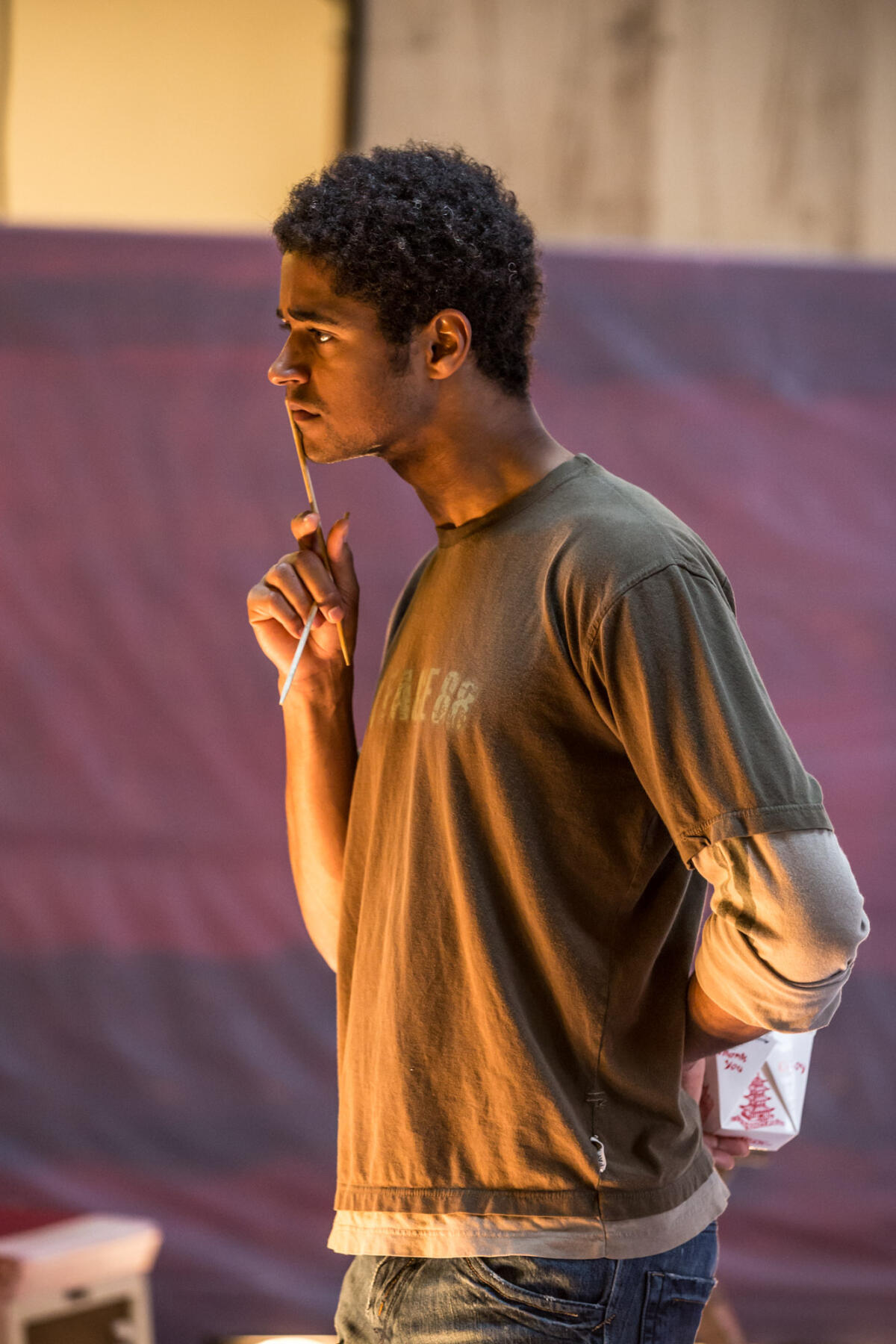
In terms of Ken’s reaction, Michael thinks it works best when Alfie is completely still and doesn’t even move his head. He wonders what Ken’s thoughts are regarding the ideas that Rothko expresses at this point: ‘A generation that does not aspire to seriousness, to meaning, is unworthy to walk in the shadow of those who have gone before, I mean those who have struggled and surmounted, I mean those who have aspired, I mean Rembrandt, I mean Turner, I mean Michelangelo and Matisse… I mean obviously Rothko.’
‘Now you agree with all of these artists?’ Michael asks Alfie. ‘Do you agree with his theory that they’ve “surmounted”? Is it absolutely ridiculous that he adds Rothko to the list?’ Fred has a view on this concerning Rothko: ‘I think he believed in his own aspiration.’ They also note that the line has a deliberately comic effect, although Michael still thinks it comments on the artist’s outlook: ‘It can be both, can’t it? Technically it can be a gag in the text while also serving Rothko’s belief.’
They run the opening scene again, both actors off book, and Michael comments on their progress so far – ‘You charted your way through there,’ then adds, ‘there are a couple of questions I have.’ He turns to Alfie, referring to Ken’s assertion, ‘I aspire to… painting’: ‘It’s not a good enough answer. He’s already told you to be specific with your words and you haven’t. It’d be quite good to see you failing here.’
Having run the scene again, Michael congratulates Fred and Alfie: ‘Both of you, that was really good. There was a duel nature to it. It gives us somewhere to go. You, Ken, got a sense of the weight of the man, Rothko, his intellect.’ He considers the interview element of the scene – Ken is there to hopefully become Rothko’s new assistant – and the artist’s speech outlining the main responsibilities of the job, ending with, ‘And anything else I want, any whim, no matter how demanding or demeaning’. Michael reflects, ‘That was the moment that the terms and conditions of your employment were laid out’. Until then Ken doesn’t know whether he’s got the job.
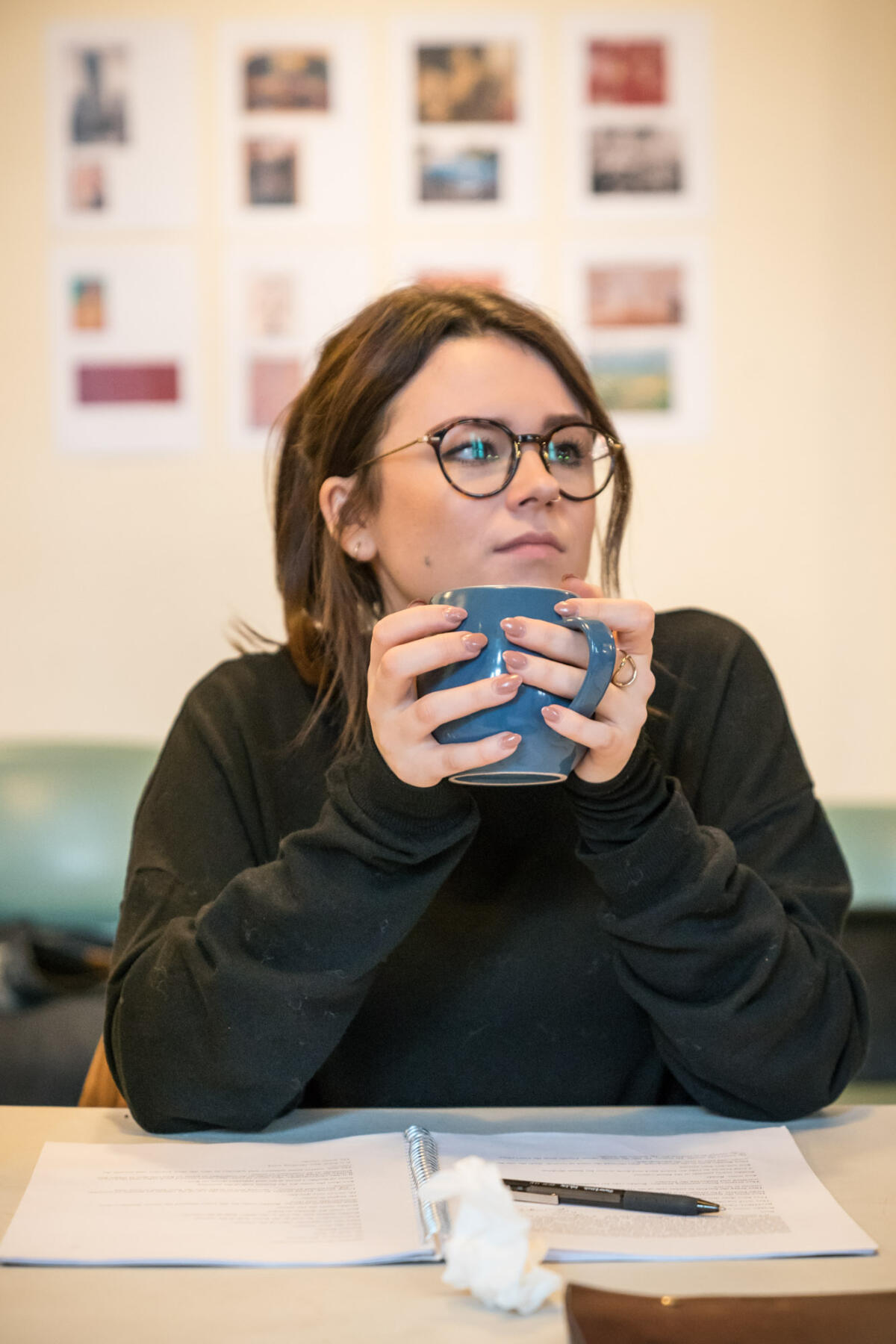
Michael asks those other members of the team present what they think of Rothko’s behavior in this scene as a prospective employer. Is there anything inappropriate? People comment on the artist’s use of the word ‘demeaning’ in addition to his smoking and drinking in the work place. Michael makes the following observation of the new production: ‘Everyone will be watching it through a different lens. I am sitting here being a different audience to the one nine years ago. It’s a very subtle shift in terms of what might get a response, what might get a laugh.’
He also considers the changing nature of language. ‘I’m intrigued by that term “like” (Rothko’s speech: ‘Of course you like it – how can you not like it?! Everyone likes everything nowadays’), it means something different now.’ Michael focuses on this particular moment with Fred: ‘Just go back over that speech. The whole thing can become…’ He thinks of the right word and Fred suggests, ‘It felt a little automatic?’ Michael recommends allowing certain moments to breathe. Having run it again, he comments afterwards, ‘You absolutely, without doing too much, let the scene have air’.
Each time they run the scene Michael focuses on different moments, this time Rothko’s fierce questioning of Ken’s wider reading: ‘Byron? Wordsworth? Aeschylus? Turgenev? Sophocles? Schopenhauer? Shakespeare? Hamlet? At least Hamlet, please God! Quote me Hamlet. Right now.’ He likes the playing of this and encourages Fred to push it even further: ‘That was good that exchange. I would love you to turn up the heat on that demand, turn up Shakespeare.’ The actors then run a short exchange – ‘Who’s your favorite painter?’ – with DSM Nicole following closely on book to make sure they get the words absolutely right.
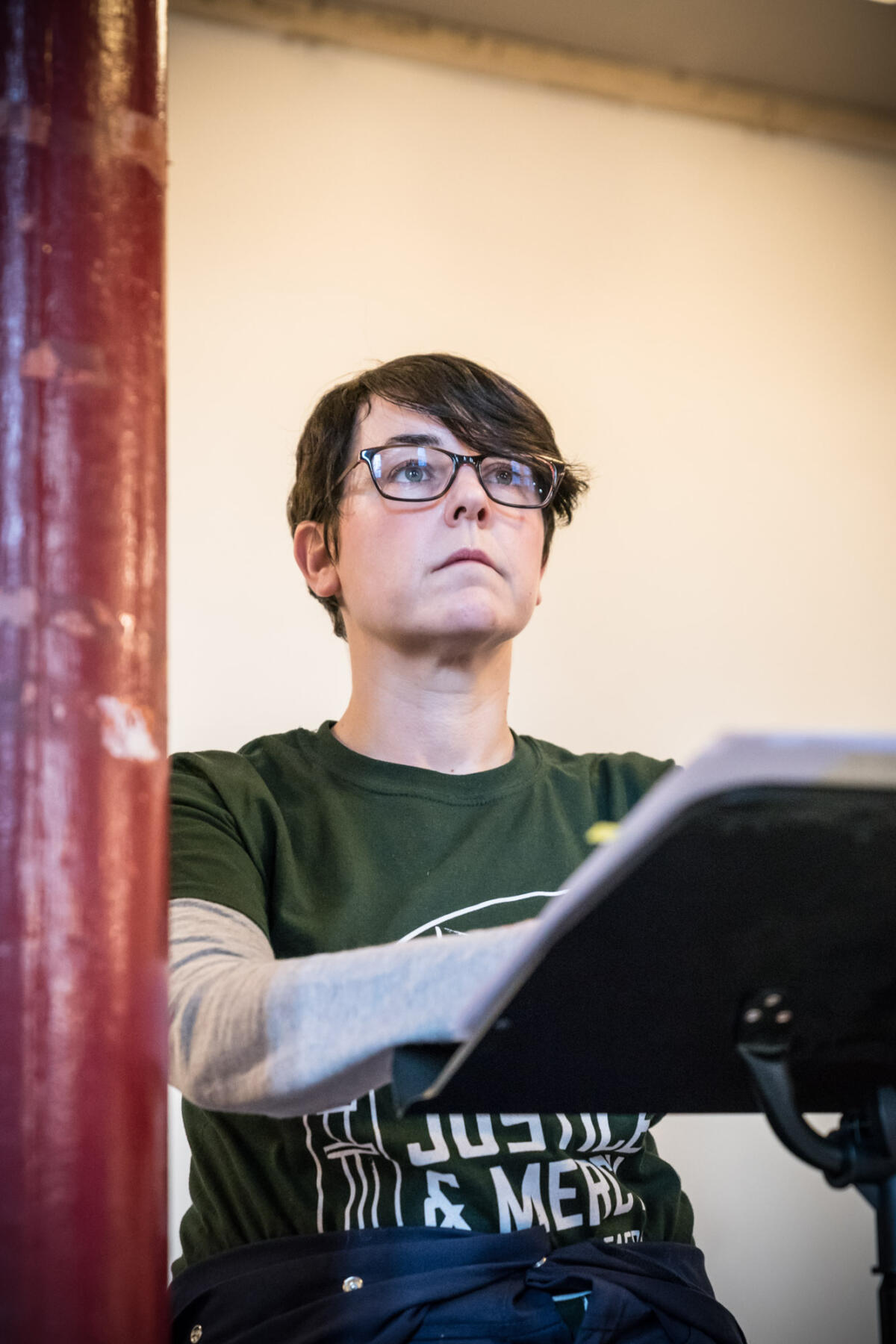
After a short break, Michael and the actors continue work on the opening scene. Fred strives to give thought to each word in Rothko’s long speeches (‘You have a lot to learn young man. Philosophy. Theology. Literature. Poetry…’), otherwise he’s concerned that ‘it sounds like a list’. Michael questions the actors about certain words, seeking to find the meaning behind them, asking Fred about Rothko’s probing of Ken: ‘Is your “tragic” what you want his “sad” to be?’ Fred thinks the artist is happy with his new assistant’s first impressions of his work: ‘I think Rothko thinks, “Good, he’s getting it”.’ Michael encourages Alfie to take longer looking at the paintings: ‘It’s a nice opportunity for us to get to know Ken. We’re only on page nine of the play.’
He considers Rothko’s description of his paintings. ‘The fact that they’re like “doom” is good for you?’ Michael asks Fred. Referring to Rothko’s line, ‘look and they are there, inescapable and inexorable’, he asks Josh for a dictionary definition of ‘inexorable’. Fred says he interprets it as unavoidable. ‘Here’s the interesting thing,’ says Fred, ‘within a few lines Rothko refers to three religious places – a chapel, a “place of communion” and a temple.’ The revelation that the paintings are actually intended for a restaurant is a powerful dramaturgical moment in the play.
They focus on Rothko’s description of the paintings: ‘My first murals… Imagine a frieze all around the room, a continuous narrative filling the walls, one to another, each a new chapter, the story unfolding…’ Again, Michael is keen to clarify different terms: ‘What makes a mural a mural as opposed to a painting?’ And later: ‘Can we have a definition of “frieze” now as well.’ Fred considers the fundamentals of the line: ‘That’s the key, “a continuous narrative”. In a way it’s the Stations of the Cross.’ Michael agrees: ‘Yes, that’s a very kind way of describing it.’
Rothko’s fee for the Seagram Murals is discussed – $35,000 in the late 1950s is the equivalent of over $2 million today. Michael and the actors consider different cultures’ attitude towards money and success. ‘Brits would generally prefer a critical hit to a commercial one, but Americans would want it the other way round,’ comments Michael. ‘They’re smart, though, they can turn a commercial hit into a critical one.’
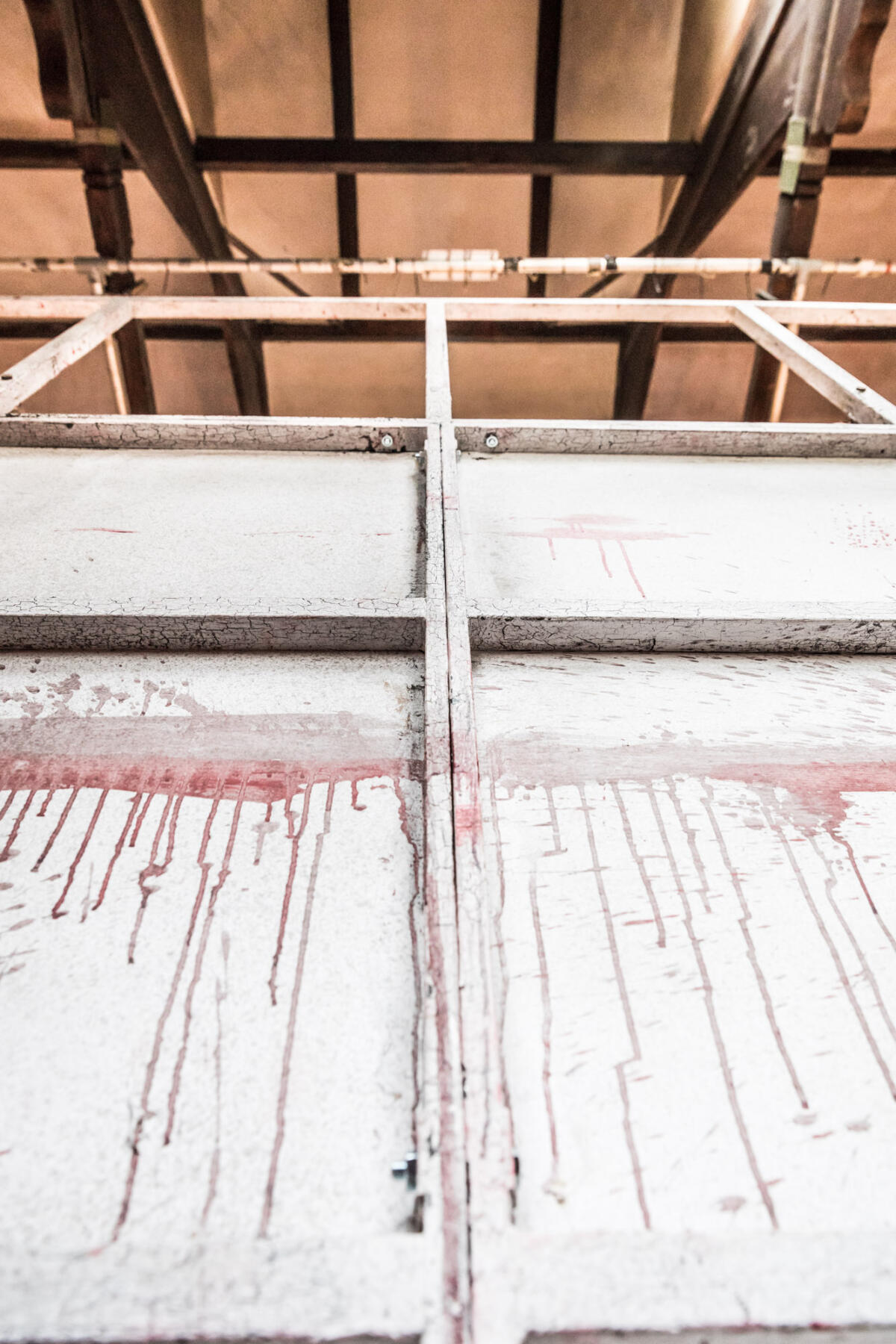
They practice the scene change from one to two, during which Rothko and Ken move the large metal scaffold, swapping the canvases that hang upon it. Michael reminds Fred that Ken is still new to Rothko and his way of working: ‘Don’t assume that he knows what to do, you have to show him.’ Having run it once, Stage Management re-set the space so they can do it again.
Looking at the start of Scene Two, in particular Ken’s reference to a Picasso exhibition at the Museum of Modern Art, Michael says to Alfie: ‘You can give yourself some time there because there’s stuff to do – eating food, the record-player’s still playing…’ Michael considers Rothko’s speech about his paintings: ‘Look at the tension between the blocks of color… They abut each other on the actual canvas, so too do they abut each other in your eye.’ He’s curious about the artist’s choice of words: ‘What’s the meaning of “abut”?’ He thinks an audience might need this particular word to be picked out – ‘You can help us there.’
Michael acknowledges the development in Rothko and Ken’s relationship from Scene One to Two – the stage-directions tell us, ‘Months have passed and he (Ken) is more comfortable here’. Michael observes: ‘You’ve moved the conversational tone up while still being confrontational.’ The artist and his assistant engage on a deeper level, discussing various artists and their work. He counsels the actors to plot their way through the conversations – ‘Where’s your discussion taking you? Take us through it a tiny bit more.’ Michael thinks this especially important when Rothko is explaining his working process to Ken.
Taking this note the actors run the scene again and Michael thinks it clearer, commenting to Fred: ‘What helped was checking-in with Ken more – “Are you getting this?” – because we follow with you. We get it partly through it being explained to Ken and partly through Ken understanding it.’
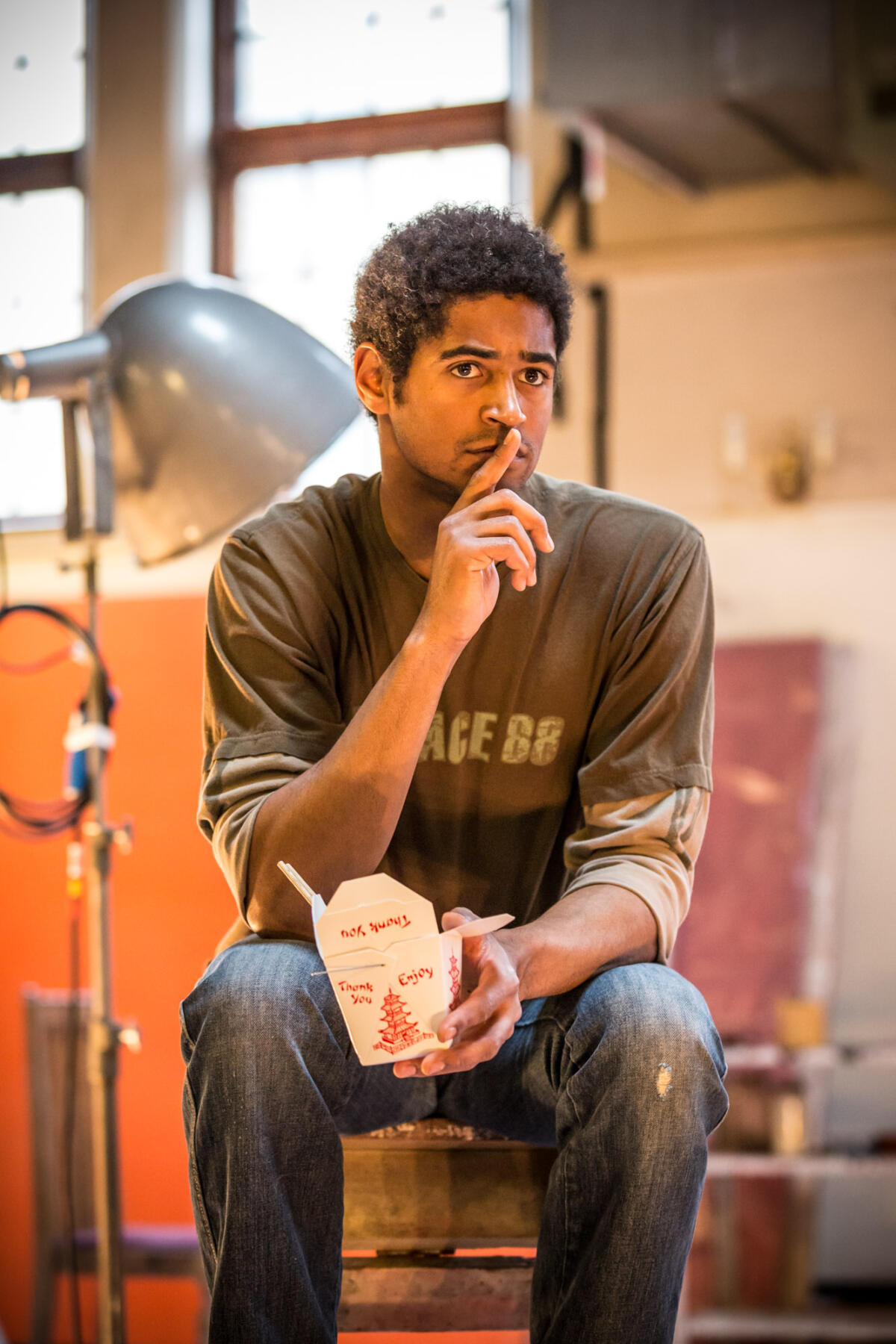
After lunch they return to Scene Two and Michael concentrates on Ken’s speech about the difference between abstract and representational painting – ‘Representational pictures are unchanging; they don’t require the active participation of the viewer. In the Louvre in the middle of the night the “Mona Lisa” is still smiling.’ Michael says to Alfie: ‘Let Ken really work his way through it. Give yourself time in the moment, in the words, to think through it. Take a little bit more time to find the Louvre moment so it comes to you, you find it.’
He then turns his attention to Rothko’s speech about Caravaggio’s painting Conversion of Saul – ‘He gives it inner luminosity. It lives…’ Michael considers its purpose: ‘The entire speech here is to let Ken, and us, know about what Rothko is trying to do – to illuminate his paintings from within.’ He asks Fred, as Rothko, ‘Was it after this that you became the painter you are now?’
Michael’s keen to ensure that any references to other artists or works of art have a purpose within the play, to further the story and develop the characters’ relationships, commenting to Fred: ‘This is true of all the illustrations you find – give Ken something with it, don’t make it nice.’ He gives a similar note with reference to Rothko’s description of The Red Studio by Matisse: ‘Just know why you want to communicate the story about Matisse’s painting. You, Rothko, have learnt that Ken is worth your opinion, telling him about the painting.’ As a general note to both actors, Michael comments, ‘You still need to create the reasons to talk’.
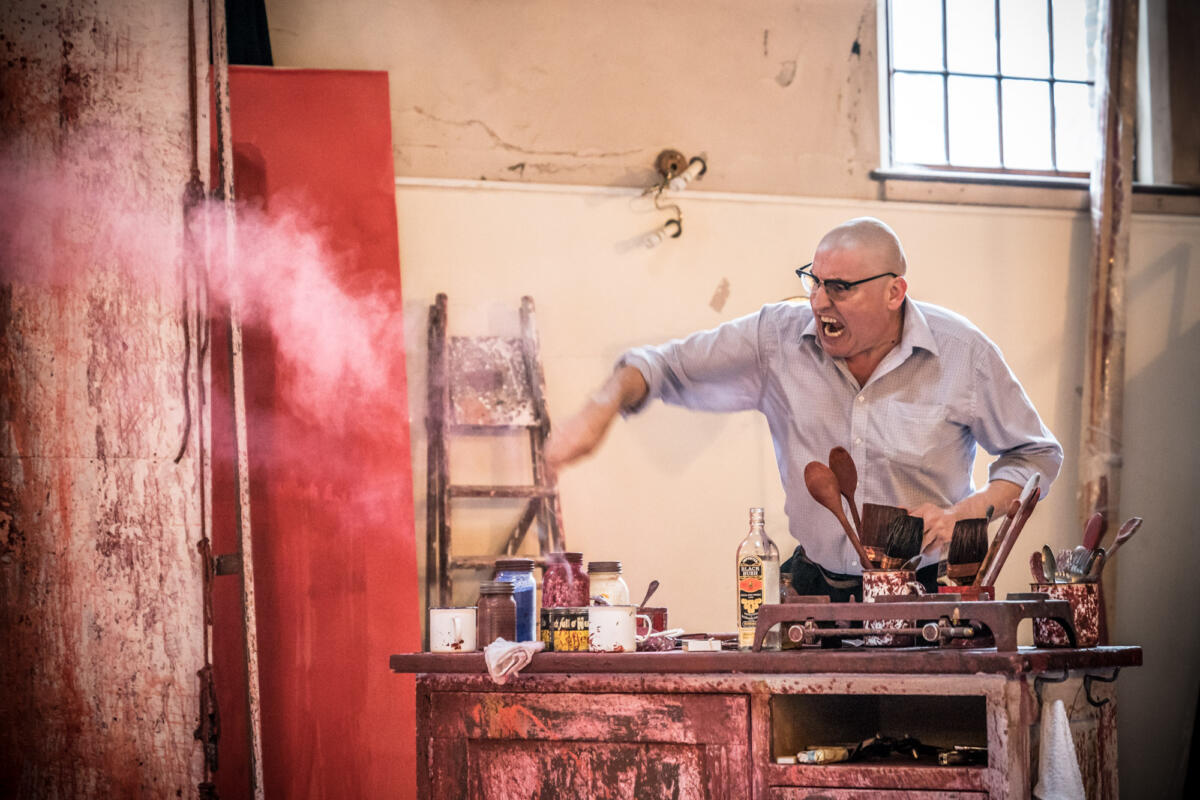
Fred thinks Rothko’s allusions to other artists and paintings reveal his insecurities about his own work, in particular his latest commission: ‘What’s released is Rothko’s own fear about whether he’s able to do this.’ Taking the scene as a whole, Michael reflects, ‘It’s a beautifully observed scene of a man with a temper and a passion at the same time’. Of the moment when Rothko’s anger erupts and he shouts at Ken, throwing paint at his assistant, Michael suggests, ‘I think it’s quite helpful if this is the first time this has happened’.
Running the scene again, Michael particularly enjoys Rothko and Ken’s duel over the various examples of red, commenting on the similarities and difference between the two men – ‘They share a colour but they don’t share a temperament.’ He looks at the escalating words between them: ‘I’d love both of you to build, build, build so you get to, “Santa Clause / Satan”.’ Michael adds to Ken: ‘You’ve got to meet his aggression with your nicer images.’
Before running a scene Michael might comment to the actors, ‘One thing you should try next time…’ and suggests, for example, a different emphasis. He regards running a scene as an opportunity to embed all the discoveries made so far: ‘I’d like to run that to consolidate all those notes.’ However, he stresses the fact that at this early stage the exploration still continues: ‘I might remind you this isn’t a runthrough so we can stop if we want to, but start to feel the rhythm of the scene.’ Afterwards he’ll give more notes: ‘Just a few little things that I’d like to try next time. There are a few tonal shifts to get us from one thing to another. It’s about a different energy.’
Looking ahead in the rehearsal process, Michael’s conscious of the transition from the rehearsal room to the theatre: ‘There’s a danger with this play in this room – I would like to encourage us to get slightly bigger with the piece each week so that we’re almost too big by the end of rehearsals in this room, so we’re ready for a bigger space.’
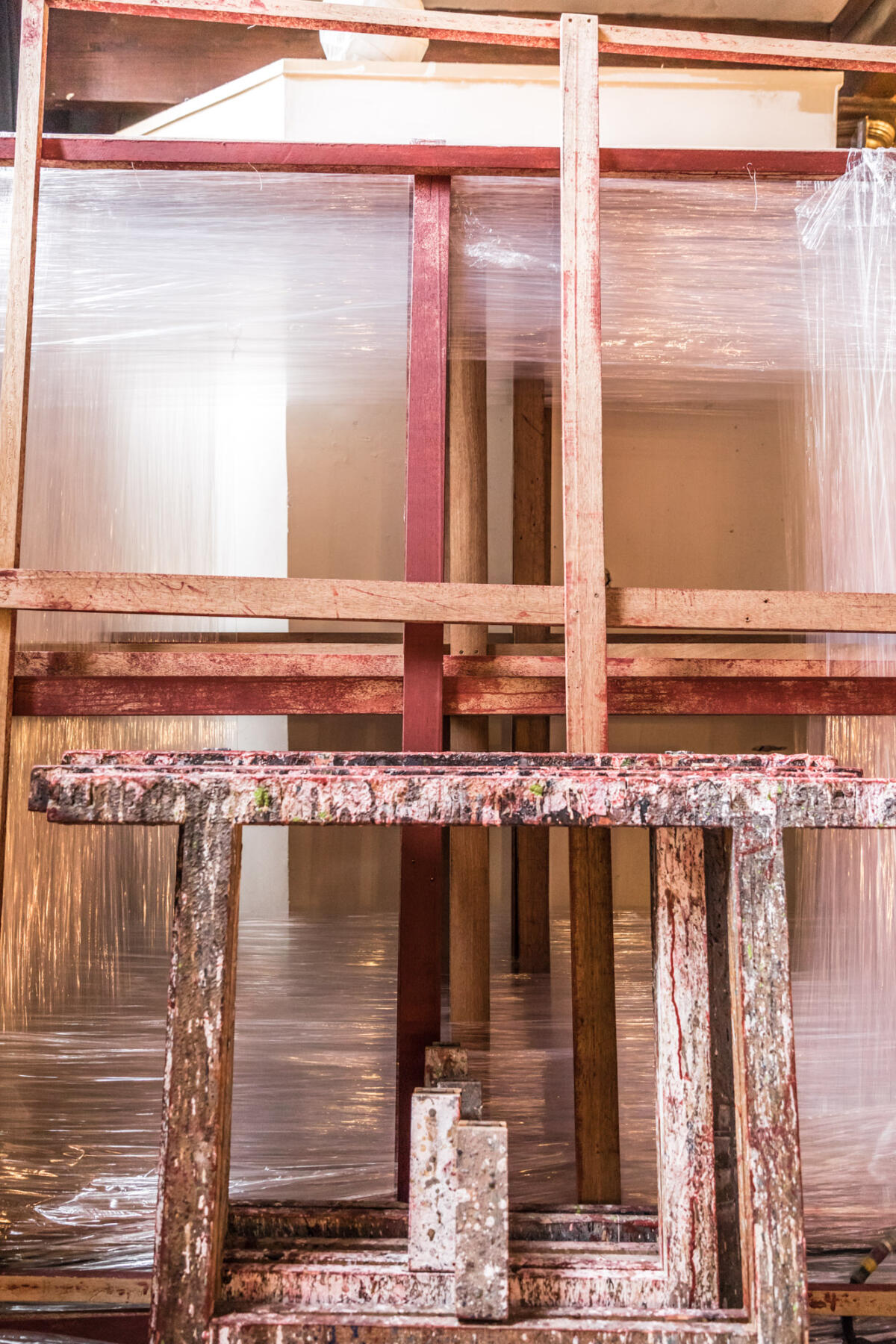
They’re making good progress and towards the end of the day they look at the transition from Scene Two into Three. Michael and the actors walk and talk their way through this long scene change, running the transition a couple of times. At the start of Scene Three, Ken enters the empty studio carrying a package wrapped in brown paper. Michael considers Ken’s handling of the package so that the audience’s attention is drawn towards it – ‘Just enough to make us think, “What’s that?”.’ He’s also keen that the scene change, in which Ken sets up the studio to prepare a canvas, is active: ‘I want you to keep it alive, opening the trestle table with the breath in the music.’
Drawing the day’s rehearsal to a close, Michael is clearly pleased with the progress they’ve made so far:
“The shape of that scene is in a really good place. You’ve taken everything I said and already started consolidating, making such strides that I’m giving you week three notes in week two. This is in a very good place to come back and talk through tone and nuance.”
